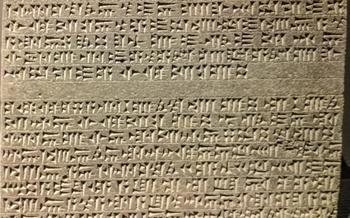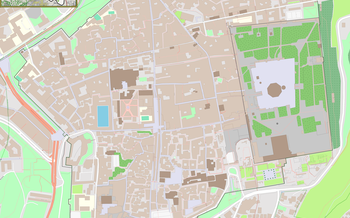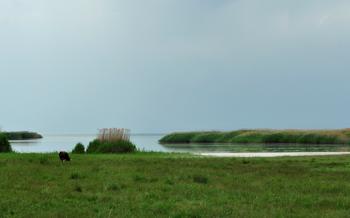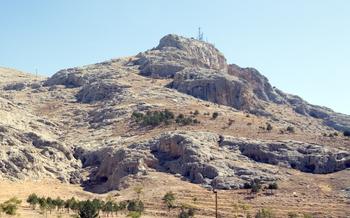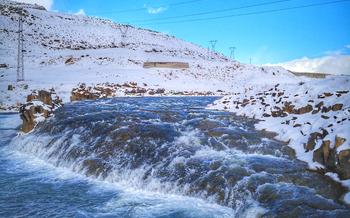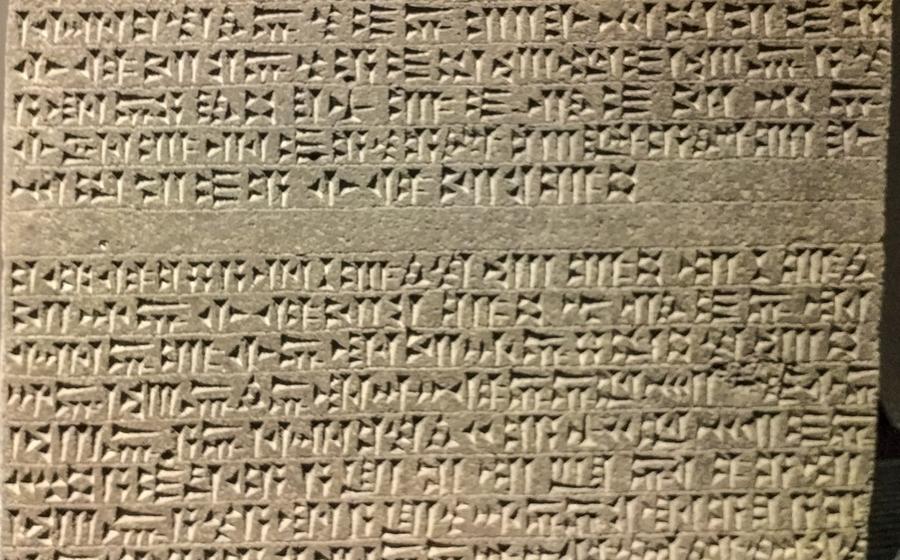
Van Fortress Urartian Cuneiform Inscription
- Van Fortress Urartian Cuneiform Inscription: A Historical Gem
- Location and Accessibility
- Historical Context
- Deciphering the Inscription
- Content and Meaning
- Preservation and Conservation
- Symbolism and Iconography
- Historical Significance
- Van Fortress: A Majestic Setting
- Exploring the Region: Unveiling the Treasures of Van Province
- Tips for Visiting
- Understanding the Urartians
- UNESCO World Heritage Status
- Local Legends and Folklore
- Insider Tip:
Van Fortress Urartian Cuneiform Inscription: A Historical Gem
The Van Fortress Urartian Cuneiform Inscription stands as a testament to the rich cultural heritage of the ancient Urartian civilization. Carved into the imposing walls of Van Fortress, this remarkable inscription has played a pivotal role in deciphering the enigmatic Urartian cuneiform script, shedding light on a civilization that once flourished in the highlands of Eastern Anatolia.
Its unique features, including the use of both Urartian and Assyrian cuneiform, have made it a valuable source of information for scholars seeking to unravel the mysteries of this ancient kingdom. Furthermore, the inscription's historical significance extends beyond its role in deciphering the cuneiform script. It provides valuable insights into the political, cultural, and religious practices of the Urartians, offering a glimpse into the intricate tapestry of their ancient civilization.
Location and Accessibility
The Van Fortress Urartian Cuneiform Inscription is situated within the confines of Van Fortress, an imposing citadel that once served as the capital of the ancient Urartian kingdom. To reach the fortress, visitors can embark on a scenic journey to the eastern shores of Lake Van, where the city of Van is nestled. From the city center, multiple transportation options are available, including public buses, taxis, or organized tours that offer a comprehensive exploration of the fortress and its surroundings.
Once within the fortress walls, visitors can embark on a captivating journey through history. Guided tours are readily available, providing insightful commentary and historical context to enhance the experience. These tours often include a visit to the Urartian Cuneiform Inscription, ensuring that visitors gain a deeper understanding of its significance. To locate the inscription independently, explore the fortress grounds, keeping an eye out for a large rock formation bearing the distinctive cuneiform script.
Historical Context
The Urartians, an ancient civilization that flourished in the region of Lake Van during the 9th to 6th centuries BC, were renowned for their advanced culture and impressive architectural achievements. Van Fortress, strategically situated on a rocky outcrop overlooking the lake, served as a significant political and administrative center for the Urartian kingdom.
Within the fortress walls, the Urartians constructed a network of fortifications, temples, and royal residences, transforming it into a symbol of their power and influence. The fortress played a crucial role in defending the Urartian kingdom against external threats and maintaining control over the surrounding territories.
Historical events leading to the creation of the Van Fortress Urartian Cuneiform Inscription remain uncertain. However, it is believed that the inscription was commissioned by a Urartian king, possibly Sarduri II, to commemorate a significant military victory or the construction of the fortress itself. The inscription provides valuable insights into the Urartian kingdom's history, their military prowess, and the significance they attached to Van Fortress.
Deciphering the Inscription
Deciphering Urartian cuneiform posed a significant challenge for scholars due to its unique script and limited known cognates. The discovery of the Van Fortress inscription proved instrumental in breaking the code. Written in a relatively clear and well-preserved state, it provided a substantial sample of Urartian text for analysis.
Key breakthroughs were achieved by comparing the inscription's symbols with those found in other known cuneiform scripts, particularly Assyrian and Babylonian. By identifying shared symbols and phonetic similarities, scholars were able to gradually decipher the Urartian language.
The process was further aided by the discovery of bilingual inscriptions, where Urartian text appeared alongside translations in other languages, such as Assyrian. These bilingual texts acted as Rosetta Stones, providing crucial clues to the meaning and pronunciation of Urartian words and grammar.
The decipherment of the Van Fortress inscription revolutionized the study of Urartian civilization. It opened doors to understanding their language, history, and culture, shedding light on a previously enigmatic kingdom that had played a significant role in the ancient Near East.
Content and Meaning
The Van Fortress Urartian Cuneiform Inscription is a remarkable historical document that provides valuable insights into the Urartian civilization. The text, written in the Urartian language using cuneiform script, has been meticulously translated and interpreted by scholars, revealing a wealth of information about the Urartian kingdom and its history. The inscription mentions specific historical figures, including King Sarduri II, and recounts significant events that occurred during his reign. It also sheds light on Urartian religious beliefs and practices, mentioning various deities and rituals. The inscription's content is crucial for understanding the political, cultural, and religious aspects of Urartian society, offering a unique glimpse into the worldview of this ancient civilization.
Preservation and Conservation
The Van Fortress Urartian Cuneiform Inscription is a priceless historical artifact that requires meticulous preservation and conservation efforts to ensure its longevity. Over the centuries, the inscription has faced various challenges, including natural wear and tear, human interference, and environmental factors.
To protect this invaluable treasure, archaeologists and conservators have undertaken comprehensive measures to preserve its integrity. These efforts include regular monitoring and assessment of the inscription's condition, employing specialized techniques for cleaning and stabilization, and implementing protective measures to shield it from further deterioration.
Restoring the inscription to its original state, where possible, is also a crucial aspect of conservation work. Skilled craftsmen and conservators meticulously repair damaged sections, using techniques that harmonize with the original materials and artistry. By doing so, they aim to retain the authenticity and aesthetic integrity of the inscription while ensuring its continued existence for future generations.
Responsible tourism plays a vital role in preserving the site. Visitors are encouraged to respect the fragile nature of the inscription by avoiding touching or damaging it. Guided tours often provide valuable insights into the inscription's significance and history, while promoting responsible behavior among visitors. By fostering a sense of stewardship and appreciation, tourism can contribute to the long-term preservation of this remarkable heritage site.
Symbolism and Iconography
The Van Fortress Urartian Cuneiform Inscription is adorned with a wealth of unique symbols and motifs that hold deep cultural and religious significance. These symbols provide valuable insights into Urartian art and iconography, shedding light on their beliefs, practices, and worldview.
One prominent symbol is the winged sun disk, a recurring motif in ancient Near Eastern art. In the Urartian context, it represents the supreme deity Haldi, the patron god of the kingdom. It symbolizes divine protection and power, often appearing in scenes of battle or royal ceremonies.
Another significant symbol is the sacred tree, which represents the Tree of Life. It embodies fertility, abundance, and the continuity of life. Depictions of the sacred tree are often accompanied by figures of animals, birds, and other creatures, symbolizing the interconnectedness of all living things.
Animals, both real and mythical, feature prominently in Urartian iconography. Lions, bulls, and eagles are common motifs, representing strength, courage, and majesty. Hybrid creatures, such as griffins and sphinxes, are also depicted, symbolizing the fusion of different realms and the power of the divine.
These symbols and motifs were not merely decorative elements; they held deep religious and cultural meaning for the Urartians. By deciphering and interpreting these symbols, we gain a deeper understanding of their beliefs, values, and worldview.
The Van Fortress Urartian Cuneiform Inscription, with its rich symbolism and iconography, offers a fascinating glimpse into the artistic and spiritual world of this ancient civilization. It invites us to explore the depths of their culture, beliefs, and the rich tapestry of symbols that shaped their worldview.
Historical Significance
The Van Fortress Urartian Cuneiform Inscription is a treasure trove of historical information, providing valuable insights into the Urartian civilization and the region's past. As a primary source, it offers firsthand accounts of historical events, shedding light on the political, economic, and religious systems of the Urartians. Through its detailed inscriptions, the monument unveils the names and achievements of Urartian kings, their military campaigns, and their interactions with neighboring kingdoms.
The inscription's historical significance extends beyond the Urartians themselves, as it contributes to our understanding of the broader ancient Near Eastern world. By providing a glimpse into the culture and history of a civilization that played a pivotal role in the region, the inscription allows us to piece together a more comprehensive picture of the ancient world. It helps us understand the interactions and conflicts between different civilizations, the development of trade routes, and the cultural exchanges that shaped the region's rich tapestry.
Van Fortress: A Majestic Setting
Van Fortress, where the Urartian Cuneiform Inscription resides, is an awe-inspiring testament to the grandeur of ancient architecture. Built atop a colossal hill overlooking the sparkling Lake Van, the fortress commands a strategic position that served as a formidable defense against invaders. Its imposing walls, constructed from massive blocks of basalt, stretch for over 5 kilometers, enclosing an area of approximately 120 hectares.
The fortress's architectural design showcases a blend of military prowess and aesthetic beauty. Flanked by 80 towers and bastions, Van Fortress exudes an air of impenetrable strength. Inside the fortress, visitors can explore the remains of royal palaces, temples, granaries, and workshops, providing a glimpse into the daily lives of the Urartians.
Throughout history, Van Fortress has borne witness to numerous pivotal events. It served as the capital of the Urartian kingdom during the 9th century BC and played a crucial role in their defense against the powerful Assyrian Empire. Later, it fell under the control of various empires, including the Medes, Persians, Greeks, Romans, and Byzantines, each leaving their distinct mark on its rich history.
Beyond the Urartian Cuneiform Inscription, Van Fortress is home to a wealth of other fascinating attractions and monuments. The Haldi Temple, dedicated to the Urartian chief god, stands as a testament to their religious beliefs. The Sarduri III Palace offers a glimpse into the opulence of the Urartian kings, with its grand halls and intricate carvings. The cuneiform inscriptions scattered throughout the fortress provide valuable insights into the history and culture of this ancient civilization.
Exploring Van Fortress is a journey through time, where visitors can immerse themselves in the grandeur and intrigue of the Urartian civilization. Its well-preserved ruins, coupled with the breathtaking views of Lake Van and the surrounding mountains, make Van Fortress a must-visit destination for anyone interested in ancient history, architecture, and stunning landscapes.
Exploring the Region: Unveiling the Treasures of Van Province
Beyond the captivating Van Fortress and its Urartian cuneiform inscription, the province of Van offers a wealth of historical sites and cultural experiences. Embark on a journey to discover nearby attractions that showcase the region's rich heritage.
Visit the ancient city of Tuşpa, once the capital of the Urartian kingdom. Explore its impressive ruins, including the Tuşpa Castle, and marvel at the well-preserved cuneiform inscriptions that provide insights into the city's glorious past.
Delve into the captivating history of the Armenian Genocide at the Van Armenian Genocide Museum. This poignant memorial honors the victims of the tragedy and serves as a reminder of the region's complex past.
Immerse yourself in the vibrant local culture by visiting traditional villages and engaging with the friendly locals. Experience their warm hospitality, savor the flavors of authentic Van cuisine, and discover unique handicrafts that reflect the region's rich artistic traditions.
Venture into the breathtaking natural landscapes surrounding Van. Hike to the summit of Mount Süphan, the region's highest peak, and enjoy panoramic views of the surrounding countryside. Explore the pristine waters of Lake Van, the largest soda lake in the world, and discover its unique flora and fauna.
Whether you're a history buff, nature enthusiast, or cultural explorer, Van province offers an unforgettable journey through time and tradition. Embrace the opportunity to delve deeper into the region's captivating heritage and create lasting memories.
Tips for Visiting
Best time to visit: - Spring (April-May) and autumn (September-October) offer pleasant weather for exploring the fortress.
Appropriate attire: - Wear comfortable shoes for walking on uneven surfaces. - Dress in layers to accommodate changing temperatures.
Photography guidelines: - Flash photography is not allowed to preserve the integrity of the inscription. - Tripods may be restricted in certain areas.
Guided tours: - Consider booking a guided tour for in-depth insights into the fortress and inscription. - English-speaking guides are available upon request.
Language assistance: - Learn basic Turkish phrases for easier communication with locals. - Translation apps can be helpful for understanding signs and menus.
Understanding the Urartians
The Urartians, an ancient civilization that flourished in the region of Van and Lake Van in eastern Anatolia, left behind a rich legacy that continues to captivate historians and archaeologists. Their distinct language, religion, and social structure set them apart from their neighbors.
The Urartian language, belonging to the Hurro-Urartian family, remains largely undeciphered, posing a significant challenge to scholars seeking to fully understand their written records. However, ongoing research and linguistic analysis are gradually unlocking the secrets of this ancient tongue.
Urartian religious beliefs centered around a pantheon of gods and goddesses, with the chief deity being Haldi, the god of thunder and war. Other important deities included Teisheba, the god of storms, and Shivini, the sun goddess. Religious rituals and ceremonies played a crucial role in Urartian society, and their temples and sanctuaries were adorned with intricate carvings and sculptures depicting their deities.
Their social structure was hierarchical, with a king at the apex, followed by a ruling elite comprising nobles, priests, and military leaders. The Urartians were skilled in various crafts, including metalworking, pottery, and weaving. They were also adept at hydraulic engineering, constructing extensive irrigation systems that transformed the arid landscape into fertile agricultural lands.
Archaeological excavations at Urartian sites have unearthed a wealth of artifacts, including bronze sculptures, jewelry, pottery, and cuneiform tablets. These discoveries provide valuable insights into their daily lives, artistic traditions, and economic activities. By piecing together these fragments of the past, scholars are gradually reconstructing the fascinating story of the Urartian civilization.
UNESCO World Heritage Status
The Van Fortress Urartian Cuneiform Inscription holds a prestigious position on the UNESCO World Heritage List, recognized for its outstanding universal value. It meets several criteria for inscription, including its exceptional cultural significance and its unique testimony to a vanished civilization. The site represents an important chapter in human history, providing valuable insights into the rise and fall of the Urartian kingdom.
UNESCO's recognition highlights the inscription's global importance and the need to preserve and protect it for future generations. The site's inclusion on the World Heritage List ensures international cooperation and support for conservation efforts, promoting responsible tourism and raising awareness of this remarkable piece of cultural heritage. Ongoing conservation projects aim to safeguard the inscription and its surroundings, ensuring its continued existence as a source of knowledge and inspiration for generations to come.
Local Legends and Folklore
The Van Fortress Urartian Cuneiform Inscription is not just a historical relic but also a source of local legends and folklore. The fortress and the inscription have been a part of the region's oral tradition for centuries, inspiring myths, legends, and stories that have been passed down from generation to generation. These stories often intertwine historical events with fantastical elements, adding to the site's mystique and appeal.
One popular legend tells of a hidden treasure buried beneath the fortress, guarded by ancient spirits. According to the tale, the treasure was left behind by the Urartian kings and can only be found by those who are pure of heart. Locals believe that the spirits of the Urartians still roam the fortress, protecting the treasure and guiding those who seek it with good intentions.
Another legend speaks of a secret tunnel that leads from the fortress to a hidden underground city. It is said that the tunnel was built by the Urartians as an escape route in times of danger. However, the entrance to the tunnel is well-hidden, and only those who are truly worthy can find it.
These legends and stories add a layer of enchantment to the Van Fortress Urartian Cuneiform Inscription, making it a place of mystery and wonder. They remind us that history and myth are often intertwined, and that the past continues to live on in the hearts and minds of the local people.
Insider Tip:
Venture beyond the well-trodden paths within Van Fortress and discover the hidden "Secret Garden". Nestled amidst ancient stone walls, this enchanting spot offers a tranquil oasis away from the crowds. Adorned with lush greenery, vibrant flowers, and a serene fountain, the garden exudes a magical aura that transports visitors back in time. Take a moment to relax and soak in the tranquil ambiance as you contemplate the rich history that surrounds you.
For a truly authentic culinary experience, head to the "Urartian Feast" restaurant, located just outside the fortress gates. This charming establishment specializes in traditional Urartian cuisine, lovingly prepared using ancient recipes and fresh, local ingredients. Indulge in mouthwatering dishes such as "khorovats" (grilled meats), "dolma" (stuffed grape leaves), and "tandir bread" (baked in a traditional clay oven).
As a unique souvenir to commemorate your visit, consider purchasing a handcrafted "Urartian ceramic figurine". These exquisite pieces, meticulously crafted by local artisans, depict various scenes and motifs from Urartian mythology and daily life. Each figurine is a testament to the enduring legacy of this ancient civilization and makes for a cherished keepsake.
To delve deeper into the captivating world of the Urartians, pick up a copy of "The Urartians: A Forgotten Kingdom" by renowned historian Dr. Aram Sarkisian. This comprehensive and engaging book offers a wealth of insights into their history, culture, and archaeological discoveries. Prepare to be captivated as you journey through the pages, uncovering the secrets of this enigmatic civilization.
